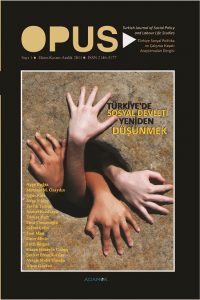Öz
Bu makalede, Osmanlı toplumsal formasyonunda vakıfların işleyişini anlamaya çalıştık. Vakıfın çok önemli bir toplumsal kurum olduğunu ve kent yoksullarına yönelik sorumluluk etiğine sahip bir kamusallık biçimini inşa ettiğini savunuyoruz. Ancak modernleşme ve batılılılaşma süreciyle, güçlü toplumsal alan bastırılmış ve yoksullara yönelik duyarlılık Devlet aygıtına devredilmiştir. Biz eleştirel olarak toplumsal alan ve işleyişindeki uzun-dönemli dönüşüm sürecini anlamaya çalıştık. 1600 tarihli İstanbul Tahrir Defterine baktık ve buradaki belgeler aracılığıyla Osmanlı toplumundaki vakıfın işleyişini ve gündelik yaşam rejimini anlamaya çalıştık.
Anahtar Kelimeler
Öz
In this article, we attempted to understand the functioning of waqf in the Ottoman social formation. We argue that waqs was very important social institution and constructed a kind of publicity that has ethics of responsibility toward urban poor. Within the modernization and westernization process, the strong social field created by waqf was oppressed and sensitivity toward poors was conveyed to State apparatus. We critically tried to comprehend this long-term transformation process in the social field and its functioning. We examined the archives of 1600 dated İstanbul Tahrir Defteri and on the basis of this document, we tried to understand the regime of everyday life and functioning of waqf in the Ottoman society.
Anahtar Kelimeler
Ayrıntılar
| Diğer ID | JA64HT24RZ |
|---|---|
| Bölüm | Makaleler |
| Yazarlar | |
| Yayımlanma Tarihi | 23 Temmuz 2016 |
| Yayımlandığı Sayı | Yıl 2011 Cilt: 1 Sayı: 1 |


